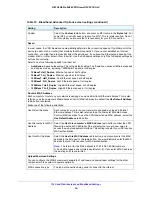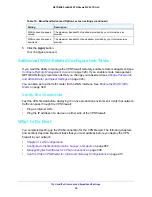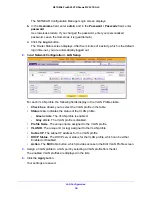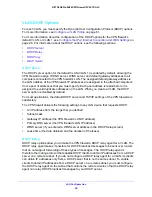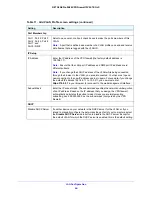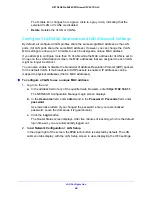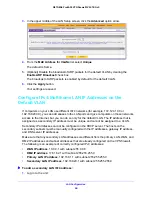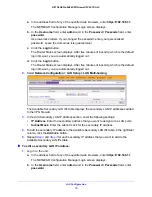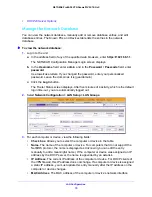
LAN Configuration
58
NETGEAR ProSAFE VPN Firewall FVS318G v2
LAN ports of the VPN firewall are assigned to the default VLAN, or VLAN 1. Therefore, by
default, all eight LAN ports use the default PVID 1. However, you can assign another PVID to
a LAN port by selecting a VLAN profile from the list on the LAN Setup screen.
After you create a VLAN profile and assign one or more ports to the profile, you must enable
the profile to activate it.
The VPN firewall’s default VLAN cannot be deleted. All untagged traffic is routed through the
default VLAN (VLAN1), which you must assign to at least one LAN port.
Note the following about VLANs and PVIDs:
•
One physical port is assigned to at least one VLAN.
•
One physical port can be assigned to multiple VLANs.
•
When one port is assigned to multiple VLANs, the port is used as a trunk port to connect
to another switch or router.
•
When a port receives an untagged packet, this packet is forwarded to a VLAN based on
the PVID.
•
When a port receives a tagged packet, this packet is forwarded to a VLAN based on the
ID that is extracted from the tagged packet.
When you create a VLAN profile, assign LAN ports to the VLAN, and enable the VLAN, the
LAN ports that are members of the VLAN can send and receive both tagged and untagged
packets. Untagged packets that enter these LAN ports are assigned to the default PVID 1;
packets that leave these LAN ports with the same default PVID 1 are untagged. All other
packets are tagged according to the VLAN ID that you assigned to the VLAN when you
created the VLAN profile.
This is a typical scenario for a configuration with an IP phone that includes two Ethernet
ports, one of which is connected to the VPN firewall, the other one to another device.
Packets coming from the IP phone to the VPN firewall LAN port are tagged. Packets passing
through the IP phone from the connected device to the VPN firewall LAN port are untagged.
When you assign the VPN firewall LAN port to a VLAN, packets entering and leaving the port
are tagged with the VLAN ID. However, untagged packets entering the VPN firewall LAN port
are forwarded to the default VLAN with PVID 1; packets that leave the LAN port with the
same default PVID 1 are untagged.
The configuration of the DHCP options for the default VLAN is described in
Configure the
IPv4 Internet Connection and WAN Settings
on page 26. For information about how to add
and edit a VLAN profile, including its DHCP options, see
Configure a VLAN Profile
on
page 61.
Assign and Manage VLAN Profiles
To assign VLAN profiles to the LAN ports and manage VLAN profiles:
1.
Log in to the unit:
a.
In the address field of any of the qualified web browsers, enter
https://192.168.1.1
.











